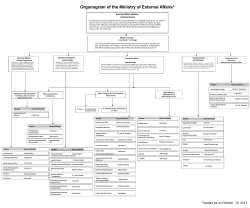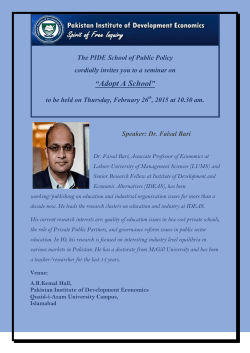
Briefing European Parliamentary Research Service
At a glance March 2015 The South Asian Association for Regional Cooperation (SAARC) SAARC was founded in 1985, and is an economic and geopolitical organisation of eight countries located in southern Asia. However, the organisation has not advanced much in its three decades of existence, mainly because of the historic rivalry between India and Pakistan. This tension has blocked initiatives on several occasions, including at the November 2014 summit. Goals and structure The South Asian Association for Regional Cooperation (SAARC) was established, following a Bangladeshi initiative, in December 1985 in Dhaka. Bangladesh, Bhutan, India, Maldives, Nepal, Pakistan and Sri Lanka were the founders, while Afghanistan joined in April 2007, to become the eighth member. The main goals of SAARC, as stated in its Charter, are: increasing the welfare of the peoples of South Asia, and the improvement of the quality of life through accelerated economic growth, social progress and cultural development in the region. The Charter provides for annual, or more frequent, summits between the heads of state or government, but in reality this has often not been the case. The most recent SAARC Summit was held in 2014, three years after the previous one. The Council of Ministers formulates the policies of the Association and decides on new areas of cooperation. Foreign Ministers of the respective countries are members of this Council, which meets twice a year. A Standing Committee, composed of Foreign Secretaries, is in charge of the approval, monitoring and coordination of the SAARC's cooperation programmes. Meetings may also be convened at ministerial level on specific themes. The SAARC Secretariat is based in Kathmandu (Nepal). The Secretary General is appointed by the Council of Ministers for a three-year term, and comes from each member state in turn (in alphabetical order). The current holder of the office, since 2014, comes from Nepal. Regional Centres covering topics such as Agriculture, Meteorological Research, Tuberculosis, Documentation, Human Resources Development, Coastal Zones Management, Information, Energy, Disaster Management, Forestry and Culture have been established in different SAARC capitals. There are nine observers at SAARC: Australia, China, the EU, Iran, Japan, Korea, Mauritius, Myanmar and the USA. They participate in the inaugural and closing sessions of SAARC Summits. SAARC countries represent 21.88% of the world's population (1.57 billion people), though they cover only 3.44% of the world's land-mass. India has 77% of the population and covers 64% of the territory of the group. All SAARC members, except Afghanistan, have a border with India. The only other common border is between Afghanistan and Pakistan. The SAARC Summit in November 2014 The 18th SAARC Summit took place in Kathmandu on 26 and 27 November 2014, and was dedicated to the issue of 'Deeper Integration for peace and prosperity'. Three agreements aimed at enhancing economic activity in South Asia were on the agenda: the 'SAARC Motor Vehicles Agreement', the 'SAARC Regional Railways Agreement' and the 'SAARC Framework Agreement for Energy Cooperation (Electricity)'. Only the latter was signed, with the signing of the other two agreements, on rail and road connectivity, blocked by Pakistan, claiming that its internal process still needed to be completed. Consensus was reached to organise a meeting of Transport Ministers within three months, in order to finalise the two agreements. However, this meeting has not yet taken place and therefore officials of four SAARC members – the 'BBIN', Bangladesh, EPRS | European Parliamentary Research Service Author: Enrico D'Ambrogio, Members' Research Service PE 551.313 Disclaimer and Copyright: The content of this document is the sole responsibility of the author and any opinions expressed therein do not necessarily represent the official position of the European Parliament. It is addressed to the Members and staff of the EP for their parliamentary work. Reproduction and translation for non-commercial purposes are authorised, provided the source is acknowledged and the European Parliament is given prior notice and sent a copy. © European Union, 2015. eprs@ep.europa.eu – http://www.eprs.ep.parl.union.eu (intranet) – http://www.europarl.europa.eu/thinktank (internet) – http://epthinktank.eu (blog) EN EPRS The South Asian Association for Regional Cooperation Bhutan, India and Nepal – met in Kolkata (India) on 2 and 3 February 2015 to negotiate a 'Motor Vehicles Agreement', which could be signed later in 2015. India put forward several initiatives during the Summit. It has committed to developing and launching a satellite dedicated for SAARC countries' use by 2016; to set up a special-purpose facility for infrastructure project-financing in the region; and to ease its visa regime for medical and business purposes – a 'SAARC business traveller card' was also proposed. The institutional capacity and the role of the Secretariat was strengthened, and it was decided to rationalise the number and activities of SAARC Regional Centres, closing and/or merging some of them. The leaders agreed to hold meetings of the SAARC Summit every two years, and meetings of the Council of Ministers once a year. Pakistan will host the 19th SAARC summit in 2016. Despite official statements, there were no tangible results and the two topics of interest at the summit were Indo-Pakistani relations and China's role within SAARC. The Prime Minister of India, Narendra Modi, held bilateral talks with all the leaders except the Pakistani Prime Minister, Nawaz Sharif. At the end of the summit, however, their long-awaited handshake was applauded by the other delegates. The following day Pakistan released 40 Indian prisoners - mainly fishermen. Another major topic was China's relations with SAARC. China borders Afghanistan, Bhutan, India, Nepal and Pakistan. It considers southern Asia to be part of the 'New Silk Road', and seeks an enhanced role within SAARC (at present, being only an observer). In this, it can count on the support of Pakistan and other members, but India has strong objections. There were suggestions in the media that China might become a full member, whereas some members proposed that China become a 'dialogue partner', able to express its views during summits or other meetings, but without voting powers. Untapped potential The Association has existed for three decades, but progress has been modest to date. However, several projects have been launched. The South Asia Free Trade Agreement (SAFTA) was signed in 2004, and it entered into force on 1 January 2006, the Trade Liberalisation Programme was started on 1 July 2006. The SAARC Agreement on Trade in Services (SATIS) was signed in 2009 and entered into force in 2012. Negotiations are ongoing for the creation of a South Asian Economic Union (SAEU) by 2030, including a free trade area, a customs union, a common market, and a common economic and monetary union. Distrust between India and Pakistan, both regional nuclear powers, has prevented SAARC from developing. As SAARC's dominant player due to its size, shared borders with other members, population and economic potential, India needs to take a leading role in the integration process. But this will only make real progress once bilateral issues no longer overshadow SAARC's agenda, since it can only advance by consensus. Southern Asia, despite assets underlined by the World Bank, for example its young population, rich water resources and the two past decades of promising development, remains home to 42% of the world's poor. Trade among SAARC members amounts to only 5% of their total trade, much lower than that of other regions. Connectivity among the member countries is another critical aspect. There is room for improvement, in order to make SAARC the platform for Southern Asia's development, and to exploit its geographical importance as the meeting point between West and East. The EU and SAARC The EU has had observer status in SAARC since 2006, and as far back as 1996, the European Commission and SAARC Secretariat signed a Memorandum of Understanding on Cooperation. This was followed by the 1999 agreement aiming at cooperation on improving market access for SAARC products in the EU. The Head of the EU Delegation to Nepal has also been the official EU representative to SAARC since 2012. In Regulation (EU) No 233/2014 establishing a financing instrument for development cooperation for the period 2014-20 – known as Development Cooperation Instrument (DCI) – SAARC is recognised as the main actor in the process of regional integration and dialogue in Southern Asia. The EU has allocated €3 billion to the SAARC region for 2014-20 and has expressed the will to expand partnership relations with SAARC. Relations between the European Parliament and SAARC members fall under the remit of the Delegation for relations with the countries of South Asia (DSAS). This delegation covers all the SAARC countries except Afghanistan and India, for which the EP has formed bilateral delegations. Members' Research Service Page 2 of 2
© Copyright 2025












